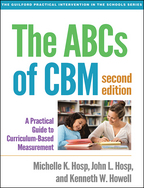The ABCs of CBM
Second Edition
A Practical Guide to Curriculum-Based Measurement
Michelle K. Hosp, John L. Hosp, and Kenneth W. Howell
A Paperback Originale-bookprint + e-book
A Paperback Original
orderApril 5, 2016
ISBN 9781462524662
Price: $49.00 244 Pages
Size: 8" x 10½"
The reproducible materials can be downloaded and printed in PDF format.
“The authors have expanded their practical guide to CBM to include measures of multiple academic domains, including early literacy and numeracy, as well as the content areas. The book shows how CBM is an essential resource for implementing multi-tiered services and illustrates how to graph, interpret, and use CBM data to make important educational decisions. I am impressed by the expanded content, including more measures and a fuller explanation of CBM in the context of a functional assessment model. I am truly excited to make this text a centerpiece of the functional academic assessment course I will be teaching in the spring. Students will find practical, step-by-step administration, scoring, and graphing procedures; current benchmark standards and normative comparisons; and advice about data management systems.”

—Kathy McNamara, PhD, Department of Psychology, Cleveland State University
“As schools continue to adopt multi-tiered systems of support, the use of effective progress monitoring tools such as CBM is critical to their success. This book is the most useful resource that I have seen to date for helping teachers implement CBM. It’s filled with reader-friendly explanations and detailed examples, and contains all the ‘whys’ and ‘hows' needed to use CBM effectively.”

—Charles A. Hughes, PhD, Special Education Program, The Pennsylvania State University
“This is a significant revision of a widely used and respected text. Trainers and training programs should consider its use. It is the right introduction to CBM for educators.”

—Theodore J. Christ, PhD, Department of Educational Psychology and Director, Center for Applied Research and Educational Improvement, University of Minnesota
“This user-friendly 'how-to' manual is impressive in its coverage of CBM across age levels and academic areas. Given the extensions and developments in CBM over the past 10 years, the second edition is a welcome update. I recommend it as a reference for teachers, school psychologists, and administrators, or as a text for university classes on assessment, progress monitoring, or models of special services implementation, such as response to intervention or multi-tiered systems of support.”

—Christine Espin, PhD, Department of Special Education, Leiden University, The Netherlands
“As a 'nuts and bolts' book, this is a direct and low-inference text with high-value results, just like the measures it describes. Read it and use it—because the instructional and curriculum decisions you make really do matter.”

—Edward J. Kame'enui, PhD, Dean–Knight Professor Emeritus, College of Education, University of Oregon
—Kathy McNamara, PhD, Department of Psychology, Cleveland State University
“As schools continue to adopt multi-tiered systems of support, the use of effective progress monitoring tools such as CBM is critical to their success. This book is the most useful resource that I have seen to date for helping teachers implement CBM. It’s filled with reader-friendly explanations and detailed examples, and contains all the ‘whys’ and ‘hows' needed to use CBM effectively.”
—Charles A. Hughes, PhD, Special Education Program, The Pennsylvania State University
“This is a significant revision of a widely used and respected text. Trainers and training programs should consider its use. It is the right introduction to CBM for educators.”
—Theodore J. Christ, PhD, Department of Educational Psychology and Director, Center for Applied Research and Educational Improvement, University of Minnesota
“This user-friendly 'how-to' manual is impressive in its coverage of CBM across age levels and academic areas. Given the extensions and developments in CBM over the past 10 years, the second edition is a welcome update. I recommend it as a reference for teachers, school psychologists, and administrators, or as a text for university classes on assessment, progress monitoring, or models of special services implementation, such as response to intervention or multi-tiered systems of support.”
—Christine Espin, PhD, Department of Special Education, Leiden University, The Netherlands
“As a 'nuts and bolts' book, this is a direct and low-inference text with high-value results, just like the measures it describes. Read it and use it—because the instructional and curriculum decisions you make really do matter.”
—Edward J. Kame'enui, PhD, Dean–Knight Professor Emeritus, College of Education, University of Oregon



